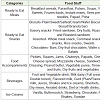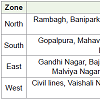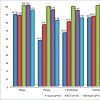Research Article
Food Labeling on Ready to Eat Convenience Foods in Jaipur City
Hema Kothari1, Arpana Indoria2* and Nimali Singh3
1Subodh PG Mahavidyalaya, Rajasthan, India
2Department of Home Science, University of Rajasthan, Rajasthan, India
3Department of Home Science, University of Rajasthan, Rajasthan, India
Corresponding author: Arpana Indoria, Research Scholar, Department of Home Science, University of Rajasthan, Jaipur, Rajasthan, India, Tel: 9983499065; E-mail: indoria.arpana@gmail.com
Citation: Kothari H, Indoria A, Singh N. Food Labeling on Ready to Eat Convenience Foods in Jaipur City. Indian J Nutri. 2017;4(5): 177.
Copyright © 2017 Kothari H, et al. This is an open access article distributed under the Creative Commons Attribution License, which permits unrestricted use, distribution, and reproduction in any medium, provided the original work is properly cited.
Indian Journal of Nutrition | ISSN: 2395-2326 | Volume: 4, Issue: 5
Submission: 29-10-2017; Accepted: 21-11-2017; Published: 23/11/2017
Abstract
Food safety is a major concern nowadays, for making food choices. The aim of the study was to examine the food labels and their compliance with the food labeling laws by Codex Alimentarius. A total of 884 ready to eat convenience food products from eight grocery outlets were surveyed and information present on food labels was compared against Codex guidelines to check the compliance of food labeling laws. According to Codex Alimentarius all pre-packaged food should have following mandatory food label information on the products that are name, address, date, origin, ingredient, additives and health claim. It was concluded that in all the products, maximum products had the name visible (91.06%), with logo present (89.14%), and the addresses of the manufacturer (88.57%) on them. Out of the above stated 4 pre packaged food products, the information regarding labeling, address of the manufacturer and origin of country were 100% declared. On the other hand the entire ready to eat meals and snacks displayed the address of manufacturer according to Codex Alimentarius Standard. Maximum products displayed information regarding address of manufacturer, logo, visible product name, vegetarian/non-vegetarian, net content. This suggests that compliance of all food labeling laws by Codex Alimentarius Commission was not found to be satisfactory. The compliance of Indian packaged foods with food labeling requirements is sub-optimal.
Keywords:
Food label; Market survey; Convenience foods products
Introduction
Food and health are two interrelated concepts that are or rather should be concerns for the food industry, governments, and consumers alike. Health is purely based on the nourishment the food provides. As a transitional economy India, is facing numerous challenges, among which the health status of the population is the alarming one. The mortality from non communicable diseases has constantly increased and the mortality rates from cancer have almost doubled in India over the past two decades. The health deterioration of the Indian population during transition is thought to be linked to a wide range of lifestyle factors among which diet and sedentary life patterns contribute substantially [1]. Globally, diet-related chronic disease-including obesity, diabetes, cardiovascular disease, cancer, osteoporosis, and dental diseases-are on the rise. According to WHO “consumers require accurate, standardized and comprehensible information on the content of food items” to make healthy food choices [2,3].
There is a need to reduce chronic disease risk, and for that individuals and populations should limit their intake of saturated, trans fat, cholesterol, and simple and added sugars, along with energy balance [3].
According to a recent report by India Brand Equity Foundation “the notable trends in the Indian food processing sector are: higher consumption of horticulture crops, emphasis on healthier ingredients (consumers prefer foods with lower carbohydrate content, low cholesterol edible oils), packaging as a purchase influencer and communicator and a shift from usefulness in processing to usefulness to consumers” [4].
“Food safety is developing into one of the most urgent issues that confront the international community due to increasing globalization of trade in food. While international regulations are available for almost all categories of products, there are variations in regulations followed by individual member nations, including India, as they are free to adopt, modify or have their own regulations” [5]. “The relationship between food safety and food quality is linked to food choice and consumer demand” [6].
Food labels serve as the tool for making need based food choices. The aim of the study was to examine the food labels and their compliance with the food labeling laws by Codex Alimentarius Commission (CDC).
Methodology
A total of 884 ready to eat food products from eight grocery outlets were surveyed and information present on food labels was compared against CDC guidelines to check the compliance of food labeling laws (Table 1). The study was carried out in Jaipur city which was divided in to four zones east, west, north, and south, respectively (Table 2). There were two criteria for sample selection i.e. inclusion criteria and exclusion criteria. The conditions for inclusion criteria of food products were that products should be labeled, packaged, commonly consumed and available in the grocery stores, whereas food products were excluded from selection which were loosely packed, not labeled, animal infested/spoilt etc.
The selection of shops for the purpose of data collection was done in accordance to the map of Jaipur city.
The following information was checked on the label of pre packaged foods as applicable to the food, in accordance to the codex standards [7].
ο The date of minimum durability had to be declared.
ο It should consist at least of, the day and the month for the products with a minimum durability of not more than three months.
ο The date has to be declared by the words. “Best before….” Where the day has been indicated.
ο The day month and the year had been declared in encoded numerical sequence except that the month should indicate by letters in these countries where the use does not confuse the consumer.
Results
Eight retail outlets of 4 zones in Jaipur city were identified and packaged food products available at these outlets were analyzed for the food and nutrition label information available. Table 3 depicts the food labeling information present of different types of food products. Maximum products displayed information regarding address of manufacturer, logo, visible product name, vegetarian/non-vegetarian, net content. This suggests that compliance of all food labeling laws by Codex Alimentarius was not found to be satisfactory.
Codex Alimentarius listed energy, protein, carbohydrate, total fat, saturated fat, sodium and total sugars as mandatory nutrient for which information had to be present on labels. Figure 1 reveals that 100% compliance was reported for energy information on beverages and accompaniments labels. Least reported nutrient was saturated fat in beverages (18.92%).
Discussion
India is experiencing a nutrition transition with the consumption of packaged foods rapidly increasing. Nutrition labels are essential if consumers are to understand the healthiness of these products. In 2011 the Food Safety and Standards Authority of India introduced regulation defining national nutrition labeling requirements and the Codex Alimentarius has recommended a global standard. The compliance of Indian packaged foods with food labeling requirements is sub-optimal. With the Indian population likely to consume much more packaged food over coming years full and effective food labeling will be essential [8].
Conclusion
Business houses into packaged foods need to be aware and vigilant regarding food and nutritional labeling. In the coming years consumer awareness is likely to be on rise and stringent government rules regarding providing license and keeping a check on the claims of manufacturer regarding labeling would make it necessary to abide the rules by the manufacturers. Bigger business houses may play as threats to small units of packaged food industry. Therefore, there is an urgent need to educate the small players in this field to make strategies which could be helpful in their survival in the competitive world of packaged and convenience foods.
References
- Ashavaid TF, Todur SP, Dherai AJ (2004) Health status of indian population--current scenario. J Assoc Physicians India 52: 363-369.
- World Health Organization (2004) Global strategy on diet, physical activity and health. Geneva, Switzerland, Europe.
- World Health Organization (2003) Diet, nutrition and the prevention of chronic diseases. WHO technical report series 916, Geneva, Switzerland, Europe, pp. 1-149.
- India Brand Equity Foundation (2017) Food processing.
- Prakash J (2013) The challenges for global harmonization of food safety norms and regulations: issues for India. J Sci Food Agric 94: 1962-1965.
- Grunert KG (2013) Nutrition labeling. In: Caballero B (Ed.), Encyclopedia of human nutrition (3rdedn). Academic Press, USA, pp. 315-319.
- World Health Organization (2008) Codex Alimentarius Commission guidelines on nutrition labeling. Food and Agriculture Organization of the United States, USA.
- Jhonson C, Dunford E, Guggilla R, Neal B (2014) The compliance of packaged food products in India with National and international nutritional labeling standards. J Nutr Intermed Metab 1: 29.



